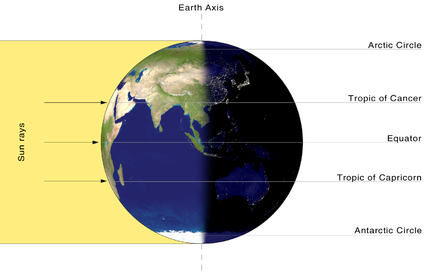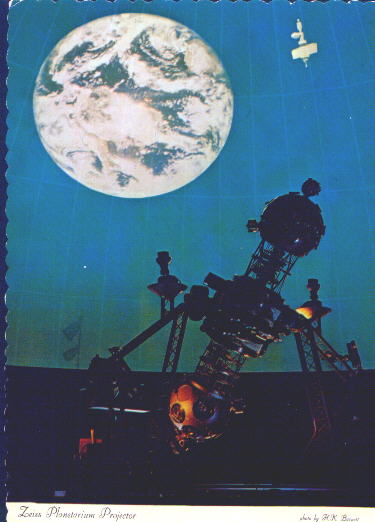
This diagram shows the Earth at an Equinox. The Vernal Equinox occurs Thursday.
(Image Source: NASA)
By Glenn A. Walsh
Reporting for SpaceWatchtower
The Vernal Equinox, which marks the beginning of the season of Spring in the Northern Hemisphere, occurs in 2014 on Thursday Afternoon, March 20 at 12:57 p.m. EDT (16:57 Coordinated Universal Time). Although it is predicted that the unstable Polar Vortex will bring more colder-than-average temperatures to the northeastern and mid-western United States over the next week, this is the astronomical beginning of Spring in America.
In the Southern Hemisphere, this marks the astronomical beginning of the season of Autumn.
As the diagram at the beginning of this blog post demonstrates, on the day of Equinox, the Sun appears directly overhead at local Noon on the Equator. At the moment of Equinox, the Northern and Southern Hemispheres of Earth are illuminated equally. And, the time of Equinox is the only time when the terminator (dividing line on Earth between daylight and darkness) is perpendicular to the Equator.
This, and the reason for seasons on Earth in the first place, is due to the fact that Earth rotates on its axis, which is tilted at an approximate 23.44-degree angle from the plane of the Earth's orbit around the Sun. As the Earth revolves around the Sun, this axial tilt causes one hemisphere of the planet to receive more direct solar radiation during that hemisphere's season of Summer and much less direct solar radiation a half-year later during that hemisphere's season of Winter. As mentioned, during an Equinox (about half-way between Summer and Winter, and about half-way between Winter and Summer) both planetary hemispheres receive an equal amount of solar radiation.
While the Vernal Equinox, the true beginning of the season of Spring, occurs on March 20 at 12:57 p.m. (16:57 UTC), the literal equinox actually occurred on March 17, the day after this month's Full Moon which was also St. Patrick's Day. In Latin, "equinox" is defined as "equal-night," the day when daylight and darkness are about equal in length.
Such actual equal-night never occurs on the actual date of an equinox on Earth. This is due to the fact that the Sun is so large, in relation to the Earth, and, hence, the entire Sun does not appear at actual sunrise, only a portion of the Sun; it takes a few more minutes for the entire Sun to appear above the horizon. Also, due to the refractive nature of Earth's atmosphere, daylight can be seen before the Sun's disk can be observed.
The date of actual equal-night varies by a location's longitude and latitude. At the Earth's Equator, daytime is always longer than night. Hence, the Equator never has equal-night.
In Pittsburgh, equal-night occured on March 17, when sunrise was 7:28 a.m. EDT (11:28 UTC) and sunset was 7:29 p.m. EDT (23:29 UTC).
This year, there will be a rare occultation just 10 hours and 50 minutes before the Vernal Equinox. The Asteroid (163) Erigone will completely obscure the bright Star Regulus early Thursday morning, visible in a narrow path in North America.
This rare occultation of a first-magnitude star will occur on March 20 at 2:07 a.m. EDT (6:07 UTC), visible in a path that includes New York City, Fairfield County, Connecticut, as well as parts of Bermuda, New York State, and Ontario. For people not in the narrow path, the occultation will be web-cast on the Slooh Robotic Telescope web site. More information regarding this rare occultation event:
Link >>> http://spacewatchtower.blogspot.com/2014/03/rare-starasteroid-occultation-to-be-web.html
The Vernal Equinox is used in the solar calendars of Iran and Afghanistan as the beginning of their calendar year. In ancient times, the Vernal Equinox, then celebrated by the old style calendar on or near March 25, was also the beginning of the calendar year for many ancient civilizations.
The Vernal Equinox is the also the first day of the National Cherry Blossom Festival held each year in Washington, DC. This festival commemorates the 1912 gift of 3,000 cherry trees from the Mayor of Tokyo to the City of Washington. The festival runs through April 13 this year. More information on the festival:
Link >>> http://www.nationalcherryblossomfestival.org/?id=404
More on the Vernal Equinox: Link >>> http://scienceworld.wolfram.com/astronomy/VernalEquinox.html
More on the Season of Spring: Link >>> http://en.wikipedia.org/wiki/Spring_%28season%29
More on an Equinox: Link >>> http://en.wikipedia.org/wiki/Equinox
More on Earth's Seasons:
Link 1 >>> http://en.wikipedia.org/wiki/Season
Link 2 >>> http://en.wikipedia.org/wiki/Heliocentric_view_of_the_seasons
More on the tilt of a planet's axis: Link >>> http://en.wikipedia.org/wiki/Axial_tilt
Special Thanks: Eric G. Canali, former Floor Manager of Pittsburgh's original Buhl Planetarium and Institute of Popular Science and Founder of the South Hills Backyard Astronomers amateur astronomy club.
Source: Glenn A. Walsh Reporting for SpaceWatchtower, a project of Friend of the Zeiss.
2014: 75th Year of Pittsburgh's Buhl Planetarium

Want to receive SpaceWatchtower blog posts in your inbox ?
Send request to < spacewatchtower@planetarium.cc >..
gaw
Glenn A. Walsh, Project Director,
Friends of the Zeiss < http://buhlplanetarium.tripod.com/fotz/ >
Electronic Mail - < gawalsh@planetarium.cc >
About the SpaceWatchtower Editor / Author: < http://buhlplanetarium2.tripod.com/weblog/spacewatchtower/gaw/ >
SpaceWatchtower Blog: < http://spacewatchtower.blogspot.com/ >
Also see: South Hills Backyard Astronomers Blog: < http://shbastronomers.blogspot.com/ >
Barnestormin: Writing, Essays, Pgh. News, & More: < http://www.barnestormin.blogspot.com/ >
SPACE & SCIENCE NEWS, ASTRONOMICAL CALENDAR:
< http://buhlplanetarium.tripod.
Twitter: < https://twitter.com/spacewatchtower >
Facebook: < http://www.facebook.com/pages/
Author of History Web Sites on the Internet --
* Buhl Planetarium, Pittsburgh:
< http://www.planetarium.
* Adler Planetarium, Chicago:
< http://adlerplanetarium.
* Astronomer, Educator, Optician John A. Brashear:
< http://johnbrashear.tripod.com >
* Andrew Carnegie & Carnegie Libraries:
< http://www.andrewcarnegie.
* Civil War Museum of Andrew Carnegie Free Library:
< http://garespypost.tripod.com >
* Duquesne Incline cable-car railway, Pittsburgh:
< http://inclinedplane.tripod.
* Public Transit:
< http://andrewcarnegie2.tripod.
No comments:
Post a Comment